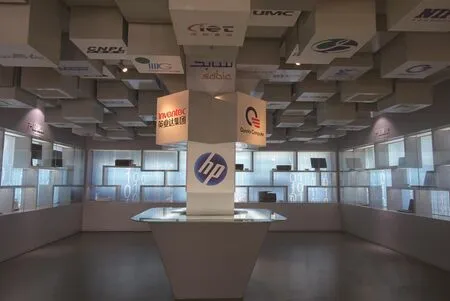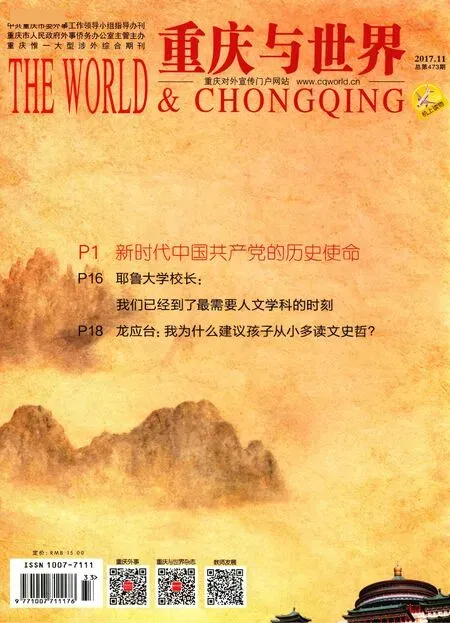Global Moguls Gathering here, Chongqing Successfully Builds a World-class Industrial Cluster
□ Article/ Journalist Xiong Yi Tr. by He Jing
Global Moguls Gathering here, Chongqing Successfully Builds a World-class Industrial Cluster
□ Article/ Journalist Xiong Yi Tr. by He Jing
IT Industry: the World’s Largest Notebook Computer Production Base

In December 2012, Todd Bradley, vice CEO of the Hewlett-Packard Development Company, L.P. (HP) had made a visit to Chongqing and said that Chongqing was an essential base for HP’s global footprint so that HP was rather optimistic about the development of Chongqing, and would further deepen the close cooperation with Chongqing and comprehensively expand the scale and lift the quality of cooperation.On August 4, 2016, HP PC Manufacturing Facility in Chongqing had seen the one hundred millionth notebook computers off the assembly line, marking a new chapter of the development of HP in China.
Over the past fi ve years, under the guidance of HP PC Manufacturing Facility in Chongqing, the IT industry,represented by notebook computers or laptops, has thrust Chongqing’s industry to step on the fast lane.“Made in Chongqing” has occupied one-third of the global notebook production. Take HP as an example, a complete industrial chain encompassing research and development (Ramp;D), production, settlement, services has been founded in Chongqing. The arrival of HP has rewritten the history of Chongqing’s industrial development. Brought along by the vertical integration
effect, a host of supporting enterprises ranking in the forefront have respectively chosen Chongqing, such as Simplo, Chicony, Hann Star, ATamp;S, Zhanyun (Quanta),Sunrex, to cite but a few; boosted by the cluster effect,brands like Acer , Asus, Toshiba, and EMS like Quanta,Compal, Wistron have also settled in Chongqing.
In August 2016, the Apple CEO Tim Cook, joining with President Gou Taiming of Foxconn Technology Group made their visit to Chongqing. The then-mayor of Chongqing, Mayor Huang Qifan met with Mr. Cook,hoping that Apple could further expand its industry chain in China and conduct in-depth cooperation with Chongqing. Mr. Cook responded to Huang that he could feel the vitality of Chongqing as he saw many young people gathering in the Chongqing Jiefangbei Apple retail store; and Apple would increase investment in China, and actively participate in China’s“Internet + amp;” Intelligent Manufacturing in China Roadmap.
Data indicate that, against the odds of 5%-shrinking of global notebook shipments in 2014, Chongqing grew by 15% thanks to its robust cluster effect; with a total volume of 61 million notebooks, it had secured its position of the world’s largest notebook computer production base. The next year, 2015, 270 million pieces, ranging from computers, monitors, printers, to network communications and other types of intelligent terminal products had been delivered in Chongqing.The year of 2016 witnessed a pool of 499.9-billion-yuan output value of Chongqing electronics manufacturing,marking that the electronic information industry contributed 33.8% to the city’s overall industrial growth,the top impetus for Chongqing’s economic growth.
In February of this year, Corning Chongqing G8.5 LCD Glass Substrate factory, the second display glass substrate production base of the United States Corning company in mainland China, was of fi cially put into operation in the Shuitu High-tech Industrial park.Other than Corning, some other electronic information industry projects featuring “huge investment, perfect starting point, high output” have consecutively settled and gone into operation, like the BOE, HKC, and ATamp;S. This serves as a proof that Chongqing electronic information industry has materialized a whole chain development from the glass substrate, LCD panel,and display module to the end product, breaking the 20-year’s monopoly pattern of the coastal areas in electronics manufacturing industry, laying foundation for the vigorous development of Chongqing industry.

Why Chongqing? Apart from the industrial agglomeration in Chongqing, preferential policies also play a vital role. In order to promote trade facilitation, Chongqing Pilot Free Trade Zone has been implementing the “Four Auto-operations amp; One Simplification” (including auto-filing, auto-assurance for write-off period, auto-report for verification, autopayment for overdue tax or tax evaded, simpli fi cation of the veri fi cation procedures) in the special supervision area of the customs since its launch 6 months ago.It is estimated that these incentive policies can save logistics costs up to 60 million yuan for HP’s notebook computer business.
When the electronic information manufacturing industry in Chongqing is developing full-fledged, its supporting logistics, fi nance, intermediary, testing and other related services have been coming into being,creating a strong industrial cluster effect. These worldclass electronic information companies have become the main driving force to promote economic growth in Chongqing, attesting the rise of China’s western worldclass electronics manufacturing highlands.
The Automobile Industry: China’s Largest Automobile Production Base
In June 2013, Alan Mulally, the President and CEO of Ford Motor Company paid a visit to Chongqing. In his words, Chongqing has been committed to creating a favorable investment environment to which Ford has a direct personal feeling. He hoped that the two sides would continue to maintain strategic partnership, constantly expanding the areas of cooperation, and propelling mutual development.
In recent years, Chang’an Ford has built three vehicle factories,an engine plant, a gearbox factory in Chongqing, forming a“trinity” of manufacturing base pattern covering vehicle, engine,and transmission. As such, Chang’an Ford Chongqing base has become the largest production base outside of the United States.Ford’s sub-brands, Mazda and Volvo have been put into operation in Chongqing; besides, Lincoln, its limousine model, has also been located in Chongqing, in a plan to be put into operation in 2019.
During October 26- 29, 2014, the then-mayor of Chongqing Mayor Huang Qifan led a delegation to visit South Korea, and further enhanced the cooperation between Chongqing and South Korea’s manufacturing enterprises, particularly to promote the Hyundai and other major South Korean projects to settle in Chongqing. On June 23, 2015, with the fifth factory in China of Beijing Hyundai Motor kicking off in the Liangjiang New Area, South Korean vehicles, for the fi rst time, had completed its layout in Chongqing. To this point,after years of “nest-building”, with a solid supporting industry basis and cluster development advantages, Chongqing has successfully secured a convergence of five vehicles categories featuring the US, the European, the South Korean, the Japanese and the local.Throughout the past five years, the automobile industry in Chongqing has been ascending new heights and rewritten records as leading industry: in 2013, it rose to be the second largest automobile production base in China; in 2014, with an annual output of 2.6 million “Made in Chongqing” vehicles, Chongqing became the No.1 automobile production base across the country;the year of 2015 saw that Chongqing auto industry built “1 +10 +1000” cluster; with its production of 305 million cars, every one in 8 cars in this country is “made in Chongqing”; and in the year of 2016, Chongqing’s vehicle production had been up to 3.16 Million,accounting for 11% of the country total; it soared to be the nation’s only city whose vehicle production had exceeded 3 million, leading the provinces and cities nationwide in terms of its automobile industry.
At the same time, Chongqing answers to the call of scienti fi c and technological and industrial revolution in automobile manufacturing industry, keeping up with the development trend of automobile industry in the world. Market-oriented, it strives to push the transition from a municipality with strong automobile industry to an even stronger, with new energy vehicles and smart cars being its major outlook. In 2015, Chongqing introduced the “New Energy Vehicles and Smart Car Industry Cluster Development Plan”,which stated that in 2020, it would have reached an annual sale of 150,000 new energy vehicles and 500,000 smart cars, respectively.At present, Chongqing has built a complete automobile industry ecological chain, with the introduction of a number of automotive Ramp;D projects involving major automobile manufacturing systems.The entering of these global automotive Ramp;D institutions in Chongqing would serve as a driver to Chongqing auto industry development. Statistics show that in 2016, Chongqing automobile manufacturing industry had totaled an output value of 539.1 billion yuan, an increase of 11.7%, and accounting for 25.4% of the city’s overall industrial output growth rate: still the pillar of the stable development of industrial economy in Chongqing.
World-class Mega-enterprises Help Chongqing Create an Open Environment
At this juncture, the leaders of the World-class Mega-enterprises like Suez Environment, Lafarge, ABB, OTIS, Carlsberg, Schneider Electric, Fanuc, have frequently visited Chongqing, followed by the settlement of a throng of world-class enterprises in Chongqing to establish production base and Ramp;D centers. These moves have played pivotal parts in Chongqing industrial added value, and the growth of industrial profits. These companies have become the“cutting-edge forces” in shaping Chongqing economic development and a robust nudge in building inland open highlands.
In fact, the impact of HP, Ford and other world-class enterprises has not just been con fi ned in the industry itself. Over the years, for paving the path of the information and the automobile industries,Chongqing has gradually established and refined a set of inland open elements, including the channels, ports, and platforms, an increasingly comprehensive security system being set up.
These beneficial explorations and practices have finally merged into three “three in one” open system features (the only inland city boasting of a railway-water-air transport hub, three national firstclass ports, and three bonded zones). China Railway Express(Chongqing), symbolized as the three “three in one” open system feature, has been actively integrating into the “Belt amp; Road”international cooperation and the Yangtze River Economic Zone development, so much so that Chongqing would be gradually turned into an open high ground from an inland hinterland .
- 重庆与世界的其它文章
- A Dialogue between Asia and Europe Initiated in Chongqing Acceleration of “The Belt and Road” and “AIIB”
- Build the Consul Highland in the Central West China 23 Consulates in Chongqing and Chengdu Help Chongqing Open Wider to the Outside World
- Opening the “Chongqing-Manzhouli-Russia” Special Train Takes Only 12 Days from Chongqing to Russia A Fruitful Result from the “China-Russia Two River Area” Conference Held in Chongqing in 2014
- 一次亚欧大陆间的对话会在重庆开启“一带一路”“亚投行”加速前行
- 中国—中东欧国家地方领导人会议·重庆2013开启中欧合作新局面“中欧班列”呈现多点快速发展
- 开通“渝满俄”专列,重庆到俄罗斯仅需12天这是2014年在重庆召开的“中俄两河流域”会议结出的硕果

